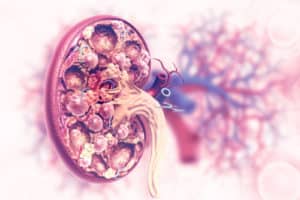What is Tuberous Sclerosis?
Tuberous sclerosis is an autosomal dominant disease with variable expression and incomplete penetrance, characterized by multiple tumors. Besides tumors, tuberous sclerosis also causes multiple skin lesions. It is also called Bourneville disease.
Cause
Tuberous sclerosis happens due to a mutation in the TSC1 gene in chromosome 9 and the TSC2 gene in chromosome 1. Normally, TSC1 gene encodes for ‘hamartin’ and TSC2 gene encodes for ‘tuberin’. The genes affected by tuberous sclerosis are tumor suppressor genes. Therefore, this disease causes multiple tumors in different organ systems.
Features
Tumors/ abnormal growths
- Brain – Hamartia (cortical tubers, can be seen in MRI), hamartoma, giant cell astrocytoma, and subependymal nodules.
- Eye – Retinal hamartoma (also known as phakoma).
- Heart – Cardiac rhabdomyoma
- Lungs – Lymphangioleiomyomatosis
- Kidney – Angiomyolipoma
- Nails – Subungual fibromata
Skin menifestations
- Depigmented ‘ash-leaf’ spots that fluoresce under UV light.
- Shagreen patches (roughened patches of skin over the lumbar spine).
- Adenoma sebaceum.
Neurological
- Mental retardation
- Developmental delay
- Epilepsy
- Infantile spasm
- ADHD
Clinical features
Clinical features depend on the type of lesions developed by the disease. Some examples are given bellow –
- Brain lesions can cause seizures, epilepsy, mental retardation, increased intracranial pressure, and stroke.
- Cardiac hamartoma can cause arrhythmia and heart failure.
- Lung cysts can cause respiratory failure.
- Renal angiomyolipoma can cause hematuria.
The complete diagnostic criteria for tuberous sclerosis is given here.
Diagnosis
Currently, no single diagnostic test exists that can diagnose tuberous sclerosis with confidence. Patients history, clinical examination, and following tests are needed to make the diagnosis.
- A prenatal ultrasonogram can detect some tumors present in the fetus.
- MRI can show the tumors developed in the brain, kidney, and other parts of the body.
- EEG can show brain waves suggestive of seizure.
- The eye examination can reveal phakoma.
- Genetic testing can detect abnormal genes.
Treatment
There is no cure for tuberous sclerosis. Only symptomatic treatment can be given. Lifetime monitoring is essential because some of the features of tuberous sclerosis takes time to develop. Patient education and support groups provide great help. Genetic counselling should be given to the patients before they reach reproductive period. Multidisciplinary care including neurologist, nephrologist, pulmonologist, cardiologist, occupational therapist, oncologist, and psychiatrist is needed to control its various symptoms.
- Epilepsy to some extent can be controlled by antiepileptics.
- Heart rhythm problems and heart failure can be managed with medications.
- Some of the tumors can be surgically resectable.
- Counselling and CBT can help with psychiatric problems.



